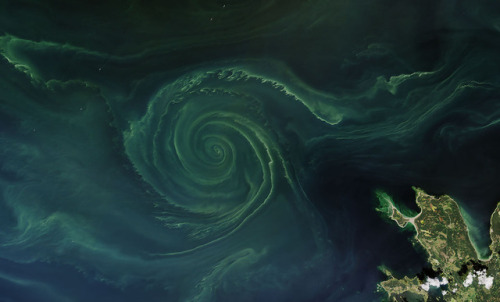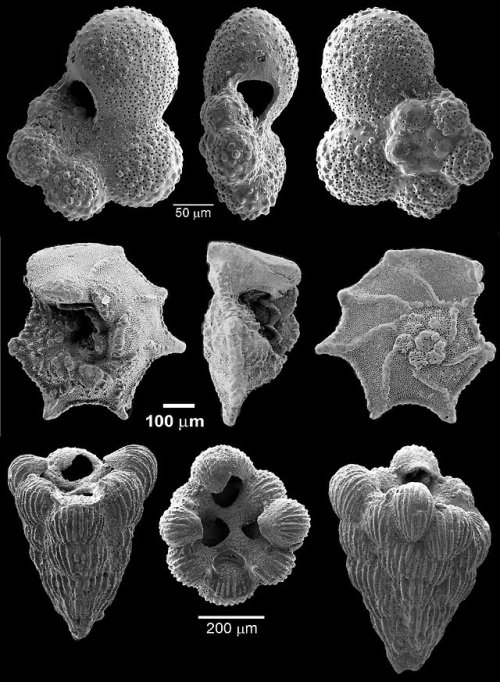The Ghost, Craig Parry’s Photo Of The Famed White Whale Migaloo Won First Place In The Underwater World

The Ghost, Craig Parry’s photo of the famed white whale Migaloo won first place in the underwater world category at the 2017 Golden Turtle International Photography Competition in Moscow this week.
More Posts from Simplyphytoplankton and Others

Blooms in the Baltic
Every summer, phytoplankton – microscopic plant-like organisms – spread across the North Atlantic, with blooms spanning hundreds and sometimes thousands of miles. Nutrient-rich, cooler waters tend to promote more growth among marine plants and phytoplankton than is found in tropical waters. Blooms this summer off Scandinavia seem to be particularly intense.
On July 18, 2018, the Operational Land Imager (OLI) on Landsat 8 acquired a natural-color image of a swirling green phytoplankton bloom in the Gulf of Finland, a section of the Baltic Sea. Note how the phytoplankton trace the edges of a vortex; it is possible that this ocean eddy is pumping up nutrients from the depths.
Though it is impossible to know the phytoplankton type without sampling the water, three decades of satellite observations suggest that these green blooms are likely to be cyanobacteria (blue-green algae), an ancient type of marine bacteria that capture and store solar energy through photosynthesis (like plants).
In recent years, the proliferation of algae blooms in the Baltic Sea has led to the regular appearance of “dead zones” in the basin. Phytoplankton and cyanobacteria consume the abundant nutrients in the Baltic ¬and deplete the oxygen. According to researchers from Finland’s University of Turku, the dead zone this year is estimated to span about 70,000 square kilometers (27,000 square miles).
Read more: https://go.nasa.gov/2uLK4aZ
Make sure to follow us on Tumblr for your regular dose of space: http://nasa.tumblr.com.

One of the major threats to sea turtles is entanglement in fishing gear and other marine debris.
Each year, threatened green sea turtles make their way to breeding grounds in the Northwestern Hawaiian Islands. Although these islands are largely uninhabited and are protected by Papahānaumokuākea Marine National Monument, ocean currents carry enormous quantities of trash here from around the world. More than 50 tons of debris enters monument waters each year! Here, fishing nets and other debris can entangle breeding adults and young hatchlings.
You can help protect these and other sea turtles by reducing the amount of plastic you use and participating in beach and watershed cleanups. What actions will you take to protect 🐢?
(Photo: Andy Collins/NOAA)
[Image description: A green sea turtle rests on a beach. In the foreground is a pile of derelict fishing nets.]

These microscopic beauties are foraminifera—single-celled organisms that live in the ocean. Since they make their shell using oxygen from the water, as ocean temperatures fluctuate through time and change the type of oxygen in the water the shells’ structure also changes. Paleontologists like the Smithsonian’s very own Brian Huber can use fossil foraminifera to track changes in Earth’s climate from over 540 million years ago.
What’s a whale fall?






Whale falls can be found throughout the ocean. This one was spotted in Channel Islands National Marine Sanctuary, off the coast of Southern California!
GIF transcript beneath the cut.
Keep reading

What a Nut!— Invasive Species Week
This ctenophore (a stingless jellyfish-like animal) called a sea walnut is native to the east coast of North and South America. In 1982, it was discovered in the Black Sea, where it was transported by ballast water. It subsequently spread to the Caspian Sea. In both places, it multiplied and formed immense populations. The sea walnuts contributed to the collapse of local fisheries because they feed on zooplankton that the commercial fish also consume. Mnemiopsis leidy has also been discovered in the Mediterranean, Baltic, and North Seas.
Photo Credit: Marco Faasse, World Register of Marine Species


🗽click here for more🗽
🗼also follow us on insta!🗼

Adjustments to a different educational landscape
Different systems
Less work
Difficulties
I thought it would be appropriate to write about the different educational landscape after taking my first round of exams for a number of reasons. First, it gives me enough time to adjust (kind of) to the different system, and secondly, it gives me a bit of time to reflect on the system as well.
I'll begin with a brief description outlining different education system. First, most students do not live on campus. Some may live two or three hours away too, which makes me feel awkward when I say I live on campus because the two hour is too long to do two times every day. Second, most classes are only once a week, which can make it easy to forget about work and procrastinate. In fact, my only class that is two times a week is my Spanish class taught by a professor with IFSA-Butler.
In my classes, there is a lot less "busy work," which is bitter sweet for me since busy work helps me stay on top of content but at the same time reduces free time. This also translate into less exams. In each of my three classes that have exams, there are only two. There is a lot of group work, usually including presentations, but in one of my biology labs, it means a lot of lab/field work. In the same course, called Evaluation of Habitat, we had two weekend trips (one to a refuge and one to a biological reserve) to complete small, independent projects.
Adjusting to this new academic system is difficult, especially with the language barrier. I also think that since there fewer numbers of classes every week, it is a lot harder to get a feel for each professor. It is difficult for me to point to few particular skills that I gained during my first year of college that I have used here because for me, I always need to experience it for myself and then I find my footing. It is hard to do it quickly, but I think that the best way for me to make the transition is to simply immerse myself in the system and my work.
IFSA-Butler's main role, especially during orientation, was giving advice to all of us and letting us know that they are there to provide support to us, including offering free tutoring to anyone who wanted it.





-
 stonemilker333 liked this · 7 months ago
stonemilker333 liked this · 7 months ago -
 presdepresde reblogged this · 7 months ago
presdepresde reblogged this · 7 months ago -
 fetidmoppets reblogged this · 7 months ago
fetidmoppets reblogged this · 7 months ago -
 tordebor reblogged this · 9 months ago
tordebor reblogged this · 9 months ago -
 thetamingoftheshrew reblogged this · 9 months ago
thetamingoftheshrew reblogged this · 9 months ago -
 guidogains reblogged this · 10 months ago
guidogains reblogged this · 10 months ago -
 guidogains liked this · 10 months ago
guidogains liked this · 10 months ago -
 angelicdesires reblogged this · 10 months ago
angelicdesires reblogged this · 10 months ago -
 reckless-blossoms reblogged this · 11 months ago
reckless-blossoms reblogged this · 11 months ago -
 33z0 reblogged this · 11 months ago
33z0 reblogged this · 11 months ago -
 53s reblogged this · 11 months ago
53s reblogged this · 11 months ago -
 wishfulfeline reblogged this · 11 months ago
wishfulfeline reblogged this · 11 months ago -
 humanoscomo-tu liked this · 11 months ago
humanoscomo-tu liked this · 11 months ago -
 almost-cosmic-dreamer reblogged this · 11 months ago
almost-cosmic-dreamer reblogged this · 11 months ago -
 interestellar reblogged this · 11 months ago
interestellar reblogged this · 11 months ago -
 scorpiotribe reblogged this · 11 months ago
scorpiotribe reblogged this · 11 months ago -
 rose-of-pollux liked this · 11 months ago
rose-of-pollux liked this · 11 months ago -
 nianna reblogged this · 11 months ago
nianna reblogged this · 11 months ago -
 slowcat420 reblogged this · 11 months ago
slowcat420 reblogged this · 11 months ago -
 slowcat420 liked this · 11 months ago
slowcat420 liked this · 11 months ago -
 ilovedirt liked this · 11 months ago
ilovedirt liked this · 11 months ago -
 53s liked this · 11 months ago
53s liked this · 11 months ago -
 fetidmoppets liked this · 11 months ago
fetidmoppets liked this · 11 months ago -
 cicadas reblogged this · 11 months ago
cicadas reblogged this · 11 months ago -
 ssnakes reblogged this · 11 months ago
ssnakes reblogged this · 11 months ago -
 youpurething reblogged this · 11 months ago
youpurething reblogged this · 11 months ago -
 jellyfairyroo liked this · 11 months ago
jellyfairyroo liked this · 11 months ago -
 babybunnywings liked this · 11 months ago
babybunnywings liked this · 11 months ago -
 stooby-doo reblogged this · 11 months ago
stooby-doo reblogged this · 11 months ago -
 cranberrybogmummymorpheme reblogged this · 11 months ago
cranberrybogmummymorpheme reblogged this · 11 months ago -
 basiliica reblogged this · 11 months ago
basiliica reblogged this · 11 months ago -
 bleugrl liked this · 11 months ago
bleugrl liked this · 11 months ago -
 deademails liked this · 11 months ago
deademails liked this · 11 months ago -
 tadpoleboy reblogged this · 11 months ago
tadpoleboy reblogged this · 11 months ago -
 periplasm reblogged this · 11 months ago
periplasm reblogged this · 11 months ago -
 sweetkuromi liked this · 11 months ago
sweetkuromi liked this · 11 months ago -
 conqueringthenoodle liked this · 11 months ago
conqueringthenoodle liked this · 11 months ago -
 offair liked this · 11 months ago
offair liked this · 11 months ago -
 sandrakkan reblogged this · 11 months ago
sandrakkan reblogged this · 11 months ago -
 twishy reblogged this · 11 months ago
twishy reblogged this · 11 months ago -
 twishy liked this · 11 months ago
twishy liked this · 11 months ago -
 mooonborne reblogged this · 11 months ago
mooonborne reblogged this · 11 months ago -
 witchweedz reblogged this · 11 months ago
witchweedz reblogged this · 11 months ago -
 witchweedz liked this · 11 months ago
witchweedz liked this · 11 months ago -
 missmassacre liked this · 11 months ago
missmassacre liked this · 11 months ago -
 alexcrystal17 liked this · 11 months ago
alexcrystal17 liked this · 11 months ago -
 tenshihime reblogged this · 11 months ago
tenshihime reblogged this · 11 months ago -
 tenshihime liked this · 11 months ago
tenshihime liked this · 11 months ago

Blog dedicted to phytoplankton. Phytoplankton are microscopic organisms that are responsible for half of the photosynthesis that occurs on Earth. Oh, and they look like art... Follow to learn more about these amazing litter critters! Caution: Will share other ocean science posts!Run by an oceanographer and phytoplankton expert. Currently a postdoctoral researcher.Profile image: False Colored SEM image of Emiliania huxleyi, a coccolithophore, and the subject of my doctoral work. Credit: Steve Gschmeissner/ Science Photo Library/ Getty ImagesHeader image: Satellite image of a phytoplankton bloom off the Alaskan Coast, in the Chukchi SeaCredit: NASA image by Norman Kuring/NASA's Ocean Color Web https://earthobservatory.nasa.gov/images/92412/churning-in-the-chukchi-sea
158 posts